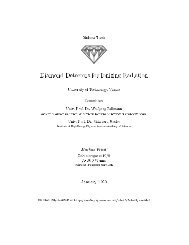Create successful ePaper yourself
Turn your PDF publications into a flip-book with our unique Google optimized e-Paper software.
Figure 2.2: Elastic proton-proton cross section over momentum transfer measured atvarious energies.2.1.7 Top QuarkThe goal of top physics at the LHC is an improved measurement of all the propertiesof the top quark, such as its production cross section, mass and spin. Top quarks willpredominantly be produced as t¯t pairs and decay almost exclusively as t → W + b.Experimental signatures of top events differ through the different decay modes of theresulting W pair.With a branching ratio of about 11%, the W pair will decay into a pair of leptons.Selecting events with lepton pairs and two b-jets provides a very clean channel wherethe main background comes from directly produced Z bosons decaying to two leptons.This background can be suppressed effectively by simply instituting a kinematic cutto remove lepton pairs whose invariant mass is consistent with a Z decay (see Fig. 2.3).Further selection criteria include the requirement of significant missing energy (fromthe W → l¯ν decay) and a lower limit for the transverse momentum of the leptons.Similar requirements apply to the semileptonic and fully leptonic decay modes (witha branching ration of about 45% each), adapted to the different particle content.Semileptonic events have four jets of which two are b-tagged and an isolated leptonwhile fully hadronic decays will have at least six jets, two of which are b-tagged. Sincethe influence of QCD backgrounds worsens with increasing number of jets, analysismethods for these signatures have to be more involved, using neural networks todetermine kinematic cuts from simulation results.6












